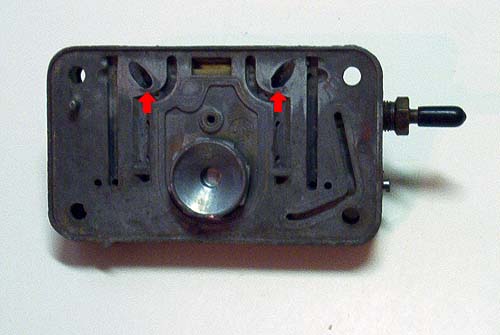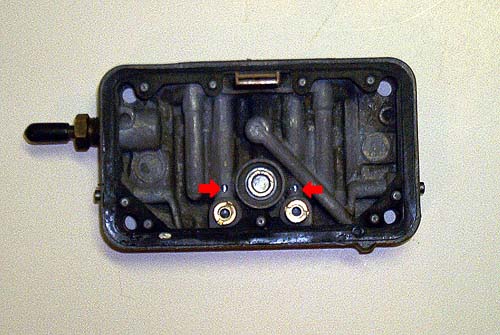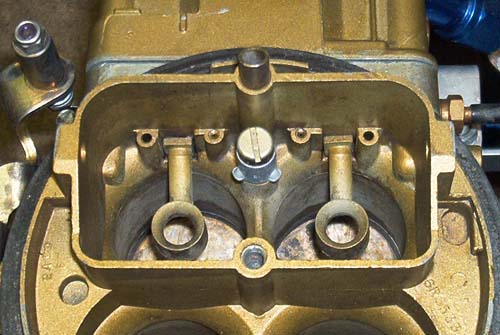
Modifying a Holley carb to alcohol
So you want to convert your Holley carb to alcohol and don't want to pay the big bucks for a shinny new one or pay to send yours away to be modified. I won't say any of the places that do the modifications are bad. They do very good work and do many other modifications to make them work more like an out of the box carb. This page will show you how to easily convert your Holley carb to alcohol. It's not magic and you will still need to tune the carb for your particular application just like any other carb.
My modifications were on a Holley 4150, list 8162, 850 CFM race carb. How well the modifications will work on a street or any Demon carb I can't say and you're on your own if something goes wrong. The basics of the modifications are to provide more fuel since you need to move almost twice as much alcohol as gasoline through the carburetor. I don't know or or intend to know how to convert a vacuum secondary carb to alcohol. These modifications are intended for a 4150 double pump carb.
You're going to need to buy some parts first. The majority of the Holley carbs do not come with these parts.
Required parts list for conversion
The majority of the modifications are done to the metering blocks. Once they've been converted to alcohol, they can't be used for gasoline any more.
Float bowl modifications
Replace the needle and seats in the float bowls with the larger flow ones. Brass floats are preferred but the plastic ones will still work fine. If you use jet extensions in the rear bowl, you'll have to use the plastic floats with the notches anyway.
Replace the standard 30cc accelerator pumps with the larger 50cc pumps.Many people feel the 30cc pump is more than enough. If you find the engine gets too much fuel from the pump shot, then reinstall the 30cc pumps.

That's about all you need to do to the float bowls. Float bowl extensions for more fuel capacity will depend on your particular application. It's up to you if you'll need them or not. With the metering block modifications for jetting, I can't say if jet extensions will help or not.

Metering block modifications
This is now were it gets interesting since once you start, you're committed to the modifications or you screw up your metering blocks.
Remove these brass well plugs any way you can. Don't damage the plug sealing surface. If your metering blocks doesn't have these plugs then the passage is plugged farther down the hole and needs to be drilled out anyway. Some plugs are installed upside down. The easiest way is to drill a small 1/8" hole into them then insert a screw to pull them out with a pair of pliers.

You must use a drill press and enlarge the hole under these plugs to .250" right down to the bottom. Use a 1/4" drill bit and don't damage the plug sealing surface! You want to see behind the jet that the drill bit has come all the way through. The drill press is required to keep the hole straight. If your carb has emulsion tubes inside the main wells, they need to be destroyed to be removed. Holley does not sell these tubes for replacement. My carb didn't have emulsion tubes so I can't offer any suggestions other than to use a different metering block for the conversion. I don't know if the carb will still work without the emulsion tubes.
Next you need to increase the size of the angle passages that feed from the main well to the booster supply passage. I used a drill bit mounted in a pair of locking pliers to do this by hand. You don't want to drill past the outer wall of the main well passage so be careful. Drill these out using a #15 drill bit.

Jet modifications require you to drill a hole just above the jets. I used a #42 drill bit to do this. These holes will allow enough fuel into the carb but still allow you to use your selection of gasoline jets. Using a #100 jet, your jetting will start at a rough equivalent of a #180 jet. Since you now have a hole drilled above the jets to allow more fuel into the carb, using jet extensions in the secondary bowl may or may not work. Although the main jets with extensions will receive fuel from the rear of the bowl during a hard launch, the holes in the metering block will not. It's up to you if you want to use jet extensions in the secondary bowls or not. When I used a single carb, I used them just because it was a better thing to do and some fuel is better than no fuel.

The last modification is to increase the size of the idle circuit to allow enough fuel for the engine to idle. Drill these holes out using a #53 drill bit.

That's it for the metering blocks. Thoroughly clean the metering block and install the new brass well plugs in the top. Replace the power valves with plugs. Since converting a carb to alcohol is a race only modification, power valves are not required.
Main body modifications
This might be the hardest step since if you screw up, someone will need to replace your boosters. They're swaged in and you need a special tool to remove and install them.
Again, using a drill bit installed in a pair of locking pliers, increase the size of this passage with a #6 drill bit. Drill in as far as you dare to go. You don't want to drill through the outer wall of the booster if you have downleg boosters.

Replace whatever squirters you have in the body with some #45's and make sure they're held down with a hollow screw.
The idle bleed holes on the primary side are drilled out. These normally only need to be modified if you can't adjust the idle mixture with the mixture screws. I never touched the secondary idle bleeds. Drill the holes out with a #33 drill bit. As with any modifications, idle and high speed bleeds are a tuning aid. None of my high speed bleeds have been drilled out. The outer holes are the idle bleeds. The inner holes are the high speed bleeds.

Finished
That's it. You've done a basic old school conversion of a Holley carb to alcohol. Clean everything again. Put #100 jets in the primary and secondary metering blocks. Install new gaskets everywhere and reassemble the carb. Adjust the idle screws to about 2-1/2 turns. Tuning is no different than a gasoline carb. Using different accelerator pump cams and squirters are tuning aids so a recommendation can't be given. Read the plugs or use an EGT to determine the best jetting. Chances are you'll run fat using the #100 jets so you can use normal gasoline jets to fine tune the jetting but you have to start somewhere. As with any Holley carb, it you can't close the throttle blades to idle low enough, drill holes in the throttle blades. Because an alcohol system needs more fuel than gasoline, upgrading your fuel system to provide all the extra fuel is also required. A BG280 pump with a front mounted cell will work but if you have a fuel cell in the rear, a BG400 or equivalent should be used. Don't forget the larger fuel lines.
You can do other simple modifications if you wish but they aren't required. Shaving off the choke horn gives a little bit more air flow. Repainting the carb to original color although isn't required, it makes it look good. When the carb is apart you could even polish the venturies. Having larger boosters installed is about the only thing you should pay for if you really want them. I'm sure there are many other modifications that could be done to make it even better but after these basic conversion changes, you now have an alcohol carb to use for a fraction of the cost of a new one or a professionally converted carb.
I now have 2 of these mounted on a tunnel ram. I still haven't fine tuned the jetting since I need 8 of each jet but the carbs work fine. Throttle response is great. It might not be as good as a new alcohol carb or having a gas one professionally modified but it works.
Disclaimer
This page is not intended to make you a master carb builder any more than a DIY page on head porting will make you a master race engine head porter. All this modification information is available in many publications. The modifications will vary from publication to publication but these are my modifications and it works for me. The pictures on this page are property of www.hardtail.com and are not to be copied for use on any other web site or publication but are free to use for your own personal carb modifications. Any modification you do to your carb is your own responsibility and I am not responsible for any damage you do to your own property or yourself. I don't want to hear about any problems you have in setting a carb up. You're trying to save a few bucks by trying to do your own conversion so hands on trial and error tuning is required. If you don't want to do this, then spend the money to have the carb professionally converted. Many of us want to do the DIY route just to say that we did it.
If however you are happy with the modifications and feel you saved a bundle doing your own conversion, a Paypal contribution payment of any amount would be appreciated to show your gratitude.
![]()